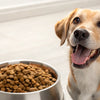Can I Feed My Dog Just Kibble? A Comprehensive Guide to Dry Dog Food
- Houndsy
Table of Contents
- Introduction
- The Nutritional Landscape of Kibble
- Can Dogs Thrive on Kibble Alone?
- Transitioning Your Dog to Kibble
- Choosing the Right Kibble for Your Dog
- The Role of the Houndsy Kibble Dispenser
- Conclusion
Introduction
As dog owners, we often find ourselves contemplating the best possible diet for our furry companions. A staggering 56% of dogs in the United States are classified as overweight or obese, which raises a crucial question: can I feed my dog just kibble? The convenience of dry dog food, often touted for its nutritional completeness and ease of use, makes it an appealing option for many pet parents. Yet, the rising popularity of fresh and wet dog foods can leave us pondering if dry kibble alone is sufficient for our pets' health and happiness.
In this blog post, we will explore the viability of feeding dogs solely dry food, covering nutritional considerations, potential health benefits, and possible drawbacks. By the end of this article, we hope to provide clarity to pet owners on whether kibble can be the sole component of their dog's diet, and if so, how to choose the best options.
We invite you to reflect on your own dog’s feeding routine and to consider whether a dry-only diet could be beneficial for them. Let’s dive into the world of dog nutrition and discover how the right kibble can support your beloved pet’s health and well-being.
The Nutritional Landscape of Kibble
Understanding Kibble Composition
Kibble, or dry dog food, is designed to provide a complete and balanced diet for dogs. High-quality kibble typically contains a blend of:
- Proteins: Essential for growth, repair, and maintenance of body tissues. Look for meat sources like chicken, beef, or fish as the primary ingredient.
- Fats: Provide energy and support skin and coat health. Healthy fats, such as omega-3 and omega-6 fatty acids, are crucial.
- Carbohydrates: Serve as a source of energy and aid in digestion. Ingredients like brown rice and sweet potatoes are often included.
- Vitamins and Minerals: Necessary for various bodily functions, from bone health to immune support.
When selecting a kibble, it's important to choose a product that meets the Association of American Feed Control Officials (AAFCO) standards, ensuring it is nutritionally complete for your dog's life stage.
The Role of Quality in Kibble
Not all kibble is created equal. The quality of ingredients can vary significantly between brands. Higher-quality kibble will have real meat as the first ingredient and avoid fillers such as corn, wheat, and soy. Investing in a premium kibble can make a substantial difference in your dog's overall health and vitality.
Can Dogs Thrive on Kibble Alone?
The Historical Perspective
For decades, dry dog food was the only commercially available option for pet owners. Many dogs thrived on these diets, and it's important to note that the nutritional standards for commercial dog food have improved dramatically over the years. Today, high-quality kibble is formulated to provide all the nutrients a dog needs to lead a healthy, active life.
Health Benefits of Feeding Kibble
- Convenience: Kibble is easy to store, measure, and serve. It doesn't spoil quickly, making it an excellent option for busy pet owners.
- Dental Health: Chewing on kibble can help reduce plaque buildup and promote better oral hygiene.
- Cost-Effectiveness: Dry dog food is generally less expensive than wet food, making it a more budget-friendly option for many households.
- Nutritional Balance: Quality kibble is designed to meet a dog’s complete nutritional needs, eliminating the need for additional supplements.
Potential Drawbacks of a Kibble-Only Diet
While many dogs can live healthily on a kibble-only diet, there are potential concerns to consider:
- Hydration: Dry food has a low moisture content. Dogs on a kibble-only diet need access to fresh water at all times to stay hydrated.
- Palatability: Some dogs may find kibble less appealing compared to wet food or fresh options, especially if they are accustomed to a different diet.
- Weight Management: Kibble can be calorie-dense, so monitoring portion sizes is crucial to prevent obesity.
Transitioning Your Dog to Kibble
If you're considering switching your dog to a kibble-only diet, a gradual transition is advisable. Here’s a step-by-step guide:
- Consult Your Vet: Before making any dietary changes, consult with your veterinarian to ensure that kibble is suitable for your dog’s specific needs.
- Start Slow: Mix the new kibble with your dog’s current food, gradually increasing the kibble ratio over several days to prevent digestive upset.
- Monitor Health: Keep an eye on your dog's weight, energy levels, and overall health during the transition. Adjust the portion sizes as needed.
Choosing the Right Kibble for Your Dog
Selecting the right kibble is crucial to ensure your dog receives optimal nutrition. Here are some factors to consider:
- Life Stage: Puppies, adults, and senior dogs have different nutritional requirements. Choose a kibble formulated for your dog's specific life stage.
- Breed Size: Large and small breed dogs may require different formulations to support their unique health needs.
- Dietary Restrictions: If your dog has allergies or sensitivities, opt for grain-free or limited-ingredient kibble.
- Brand Reputation: Research brands to find those with a history of quality and safety. Look for transparency in ingredient sourcing and manufacturing practices.
Quality Kibble Recommendations
While we won't endorse specific brands, we can suggest looking for kibbles that:
- List a high-quality protein as the first ingredient.
- Include wholesome carbohydrates such as brown rice or sweet potatoes.
- Are free from artificial additives and fillers.
- Have undergone feeding trials to demonstrate their efficacy.
The Role of the Houndsy Kibble Dispenser
At Houndsy, we understand the importance of a seamless feeding experience for both you and your dog. Our flagship product, the Houndsy Kibble Dispenser, is designed with the modern pet owner in mind. It features:
- Convenient Crank: Positioned at standing height to eliminate the need for bending, making feeding easier and more ergonomic.
- Perfect Portion Control: Dispenses the right amount of kibble every time, ensuring your dog receives consistent nutrition.
- Stylish Design: Our mid-century modern design complements your home decor, making feeding time a visually pleasing experience.
With a storage capacity of 25-30 lbs and a BPA-free liner to keep kibble fresh, the Houndsy Kibble Dispenser simplifies your dog-feeding routine while enhancing the overall experience.
Conclusion
So, can you feed your dog just kibble? The answer is yes, provided you choose high-quality kibble that meets their nutritional needs. A kibble-only diet can be convenient, cost-effective, and nutritionally balanced, offering numerous benefits such as improved dental health and ease of storage. However, it is essential to be mindful of hydration and weight management.
As responsible pet owners, it’s our duty to ensure our dogs receive the best possible nutrition. Always consult your veterinarian before making significant dietary changes and consider investing in a reliable feeding solution like the Houndsy Kibble Dispenser to enhance your dog’s feeding experience.
FAQ
1. Can my dog live solely on dry food?
Yes, high-quality dry food can provide all the necessary nutrients for your dog to thrive. However, always ensure they have access to fresh water.
2. How do I know if the kibble is of good quality?
Look for kibbles that list real meat as the first ingredient and avoid those with fillers and artificial additives. Research brands and consult your veterinarian for recommendations.
3. Should I mix wet food with kibble?
Mixing wet and dry food can offer the benefits of both, but it’s essential to ensure you’re not overfeeding. Consult your vet for guidance on proper portion sizes.
4. How often should I feed my dog kibble?
Feeding frequency depends on your dog’s age, size, and activity level. Most adult dogs do well with two meals per day, while puppies may require more frequent feedings.
5. What if my dog refuses to eat kibble?
If your dog shows disinterest in kibble, consult your vet. They might have dietary preferences or health issues that need to be addressed. A gradual transition can also help them adjust to a new diet.













